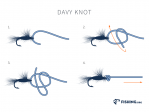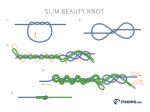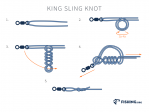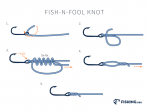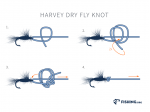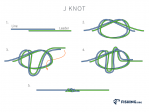Nail Knot

Nail Knot
The knot is an appropriate attachment of backing to fly lines as well as the line to the tippet or leader. The most common way of using this knot is in fly-fishing where an artificial fly is cast using a rod, a weighted line, and a reel to catch fish. While casting an almost weightless lure to attract the fish, one needs to employ the use of a casting technique that is way different from the conventional types of casting. Fly fishermen, for example, use simple flues tied by hand and that look like living organisms or invertebrates that agitates the fish and make them strike.
Many carp anglers, nonetheless, prefer using this type of knot for the attachment of monofilament fishing lines to lead the core leader component.
Trying to tie the knot by hand is almost impossible. For this reason, some people utilize the aid of a tying tool. The tool offers one a chance to tie lines and fishing braids to a broad range of hooks, lures or lead core in a short time. A nail knot's end is gripped by many turns, which do not allow the knot that you make to come untied or slip even when you make a hair loop on a carp hair rig. This is because the tag ends the one that goes under all the wraps.
Step 2:
Step 3:
To no surprise, the Nail Knot was coined because it initially required the use of a nail as the guiding tool when threading a line. Today, it is much easier to use a small tube or straw, but the name remains.
Yet, it is not the only title for this knot, some fishermen and women may know the Nail Knot as the Tube or Gryp Knot.
There are a couple of fishing techniques that use the Nail Knot.
How the Nail Knot is Mostly Used
Often used as a fly-fishing knot, this popular knot is used to connect the fly line to the leader.
Anglers usually apply the Nail Knot during carp and fly-fishing. Join two fishing lines of different diameters, fishers use Nail Knots. The line diameters and knots allow the ends to fade down the fly.
Many carp anglers favor using the Nail Knot for the attachment of monofilament fishing lines to lead the core leader component. The knot also works well in attaching the backing to fly lines and tippet or leader.
But the most common way of using this knot is in fly-fishing. This is where you cast a fly rod using an artificial fly, a weighted line, and a fly reel to catch fish.
While casting an almost weightless lure to attract the fish, one needs to manipulate the use of a casting technique different from conventional ways.
For instance, fly fishermen and women can use simple flue jigs that look similar to live bait, living organisms, or invertebrates. The purpose of the flues is to gain the attention of fish and to agitate them, so they attempt to swallow the lure, letting fly fishermen and women catch the fish.
How Difficult is it to Tie a Nail Knot?
Tying a Nail Knot is not the easiest knot to tie. Anglers typically use the aid of a tying tool as trying to tie a Nail Knot is almost impossible when trying to tie it by hand.
The tying tool enables fishermen and women to tie the lines and fishing braids to a broad range of hooks, lures, or lead cores in a short time.
The many wraps put at the end of a Nail Knot prevent it from untying or slipping out. This is the same case even when you make a hair loop on a carp hair rig.
The tag ends go under the wraps, which stops them from becoming untied.
Advantages of a Nail Knot
- Do not slip
- Tie-fast with tool
- Very strong
- Smooth and compact, making it pass easily through the guides
- Resistant to hinging
- Virtually holds no water to produce a spray
- Can be used on fluorocarbon lines
Disadvantages of a Nail Knot
- Difficult to untie.
- Hard to tie with hands
- Challenging when replacing the leader, especially in low light conditions.
- It can become tedious.
How To Tie the Nail Knot
As mentioned earlier, you no longer need a nail to tie this knot. Instead, you can use a hollow tube or straw in its place.
- Put the item against the end of a fly line and place the butt-end/butt section of the leader against it.
- The tube you used to aid you in threading the line should allow you to leave an extra 10-12" of its tag end to tie the knot.
- Make between 6 and 8 tight wraps that run from left to right. They should also go back around the leader, line, and the straw or hollow tube.
- Hold the tag end and pass it through the tube, then remove it.
- Do the same with the straw only that the tag end passes the space made by the tube itself.
- Tighten the wraps by pulling the tag end. Make sure the knot is sitting appropriately on the fly-fishing line.
- Trim tag ends close to the knot.
Conclusion
The Nail Knot is a handy tie, especially for saltwater fly fishermen and women. It makes attaching the backing to the end of the fly line and occasionally used to tie the leader to the fly line too. Which makes fly-fishing easier.
Use a Nail Knot tool to help make knot tying more comfortable on the hands. And although at one point the knot needed a nail, it is no longer necessary. Use a hollow tube to create a useful “Nail-less Nail Knot” the next time you go fly-fishing.
 Joshua Keaton
Joshua Keaton 
